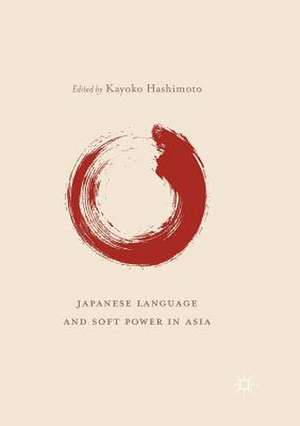Japanese Language and Soft Power in Asia
Editat de Kayoko Hashimotoen Limba Engleză Paperback – feb 2019
| Toate formatele și edițiile | Preț | Express |
|---|---|---|
| Paperback (1) | 721.63 lei 6-8 săpt. | |
| Springer Nature Singapore – feb 2019 | 721.63 lei 6-8 săpt. | |
| Hardback (1) | 726.69 lei 6-8 săpt. | |
| Springer Nature Singapore – 7 aug 2017 | 726.69 lei 6-8 săpt. |
Preț: 721.63 lei
Preț vechi: 880.05 lei
-18% Nou
Puncte Express: 1082
Preț estimativ în valută:
138.09€ • 144.54$ • 114.93£
138.09€ • 144.54$ • 114.93£
Carte tipărită la comandă
Livrare economică 31 martie-14 aprilie
Preluare comenzi: 021 569.72.76
Specificații
ISBN-13: 9789811353154
ISBN-10: 9811353158
Pagini: 207
Ilustrații: XIII, 207 p. 2 illus. in color.
Dimensiuni: 148 x 210 mm
Greutate: 0.27 kg
Ediția:Softcover reprint of the original 1st ed. 2018
Editura: Springer Nature Singapore
Colecția Palgrave Macmillan
Locul publicării:Singapore, Singapore
ISBN-10: 9811353158
Pagini: 207
Ilustrații: XIII, 207 p. 2 illus. in color.
Dimensiuni: 148 x 210 mm
Greutate: 0.27 kg
Ediția:Softcover reprint of the original 1st ed. 2018
Editura: Springer Nature Singapore
Colecția Palgrave Macmillan
Locul publicării:Singapore, Singapore
Cuprins
Introduction.- Why language matters in soft power.- Part I Cool Japan and Japan’s soft power.- Cool Japan versus the China threat: Does Japan’s popular culture success mean more soft power?.- Cool Japan and Japanese language: Why does Japan need “Japan fans”?.- Part II Japanese language and the historical construction of Asia.- Japanese language education in the Greater East Asia Co-Prosperity Sphere and the kokuji mondai (National Script Problem).- Media and cultural policy and Japanese language education in Japanese-occupied Singapore, 1942-1945.- Part III Japanese language teaching in Asia.- Japanese language for trainee nurses from Asia: the EPA scheme as a missed opportunity.- The roles of native Japanese speaker in Japanese language programs at high schools in South Korea, Indonesia and Thailand.- Japanese pop culture as a motivating factor for Japanese language learners in Qatar.- Part IV Japanese language and learners’ empowerment.- Japanese Language in the wake of Hong Kong’s Umbrella movement: Is it a form of soft power?.- Accessing the soft power of Japanese language in Australia: Young Korean migrants studying Japanese as a foreign language.
Recenzii
“This book’s biggest strength lies in its comprehensive, current outlook on Japanese language as soft power. … the book offers valuable insights into issues which have remained largely unexplored. For those wishing to obtain a sound, comprehensive understanding of and appreciation for current Japan and its attempts in creating and exercising soft power, this is an indispensable read.” (Mitsuyo Sakamoto, newbooks.asia, July 3, 2020)
Notă biografică
Dr Kayoko Hashimoto is Lecturer at School of Languages and Cultures, University of Queensland, Australia. Her main research areas are language policies and Japan’s educational policies. She has been Asian Studies Review Language and Education Thematic & Review Editor since 2013.
Textul de pe ultima copertă
This cutting edge collection considers how the Japanese language functions as a key element of Japanese soft power in Asia. Within Japanese culture itself, the promotion of language has been an area of ambivalence. This interdisciplinary book looks across the fields of language policy, language teaching, socio-linguistics, cultural studies and history to identify the links between Japan’s language policies and broader social, economic and political processes. It examines the challenges that undermine Japan’s potential soft power by identifying a gap between the “official Japan” portrayed by the Japanese government and the “cultural Japan” that foreigners perceive. It also reveals historical continuity in the way Japanese language is perceived and promoted by policy makers and how the current practices of Japanese language teaching in Asian countries have been shaped within the framework of “international exchange”, which has been a key concept in Japanese foreign policies since the 1970s. It particularly considers the concept of ‘Cool Japan’ as a symbol of Japan’s interpretation of its cultural power and offers a thoughtful assessment of the future of Japanese as a form of soft power in Asia as the country prepares for the 2020 Tokyo Olympics.
Caracteristici
Examines how Japanese functions as a key element of Japanese soft power in Asia Offers an interdisciplinary perspective on Japan’s language policies and broader social, economic and political processes Considers the future of Japanese as a form of soft power in Asia as the country prepares for the 2020 Tokyo Olympics
